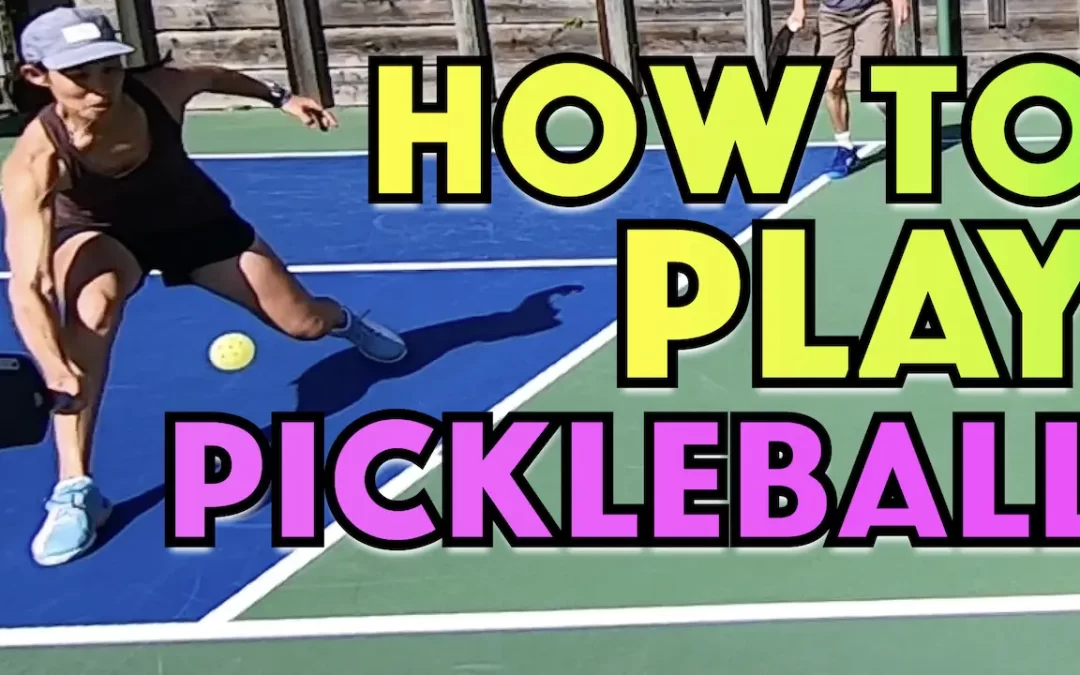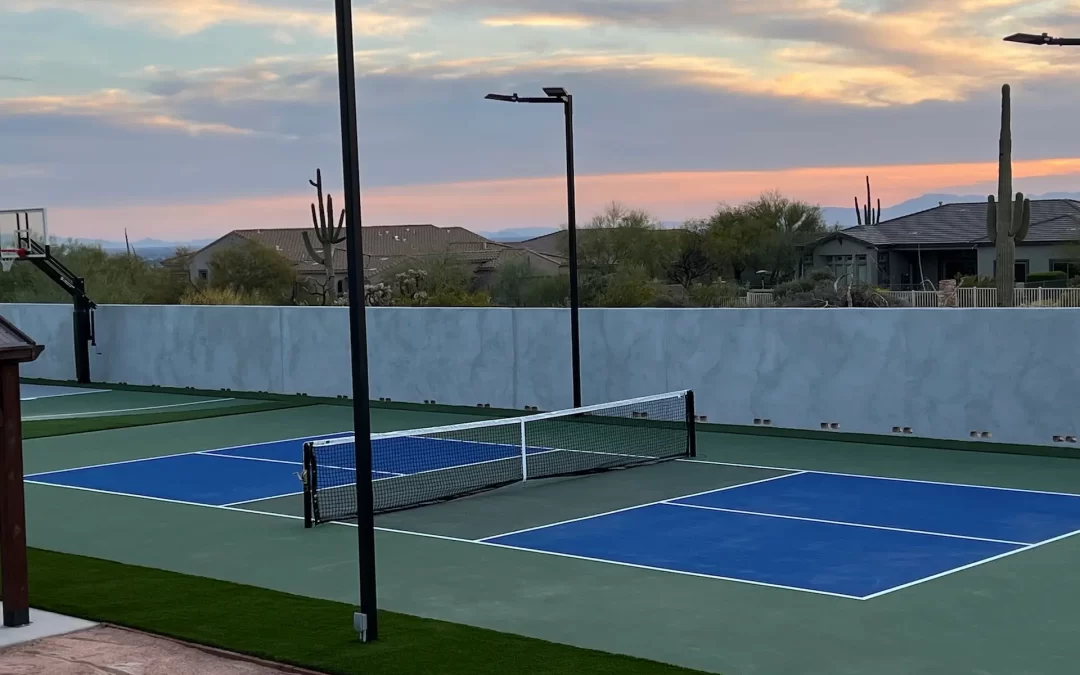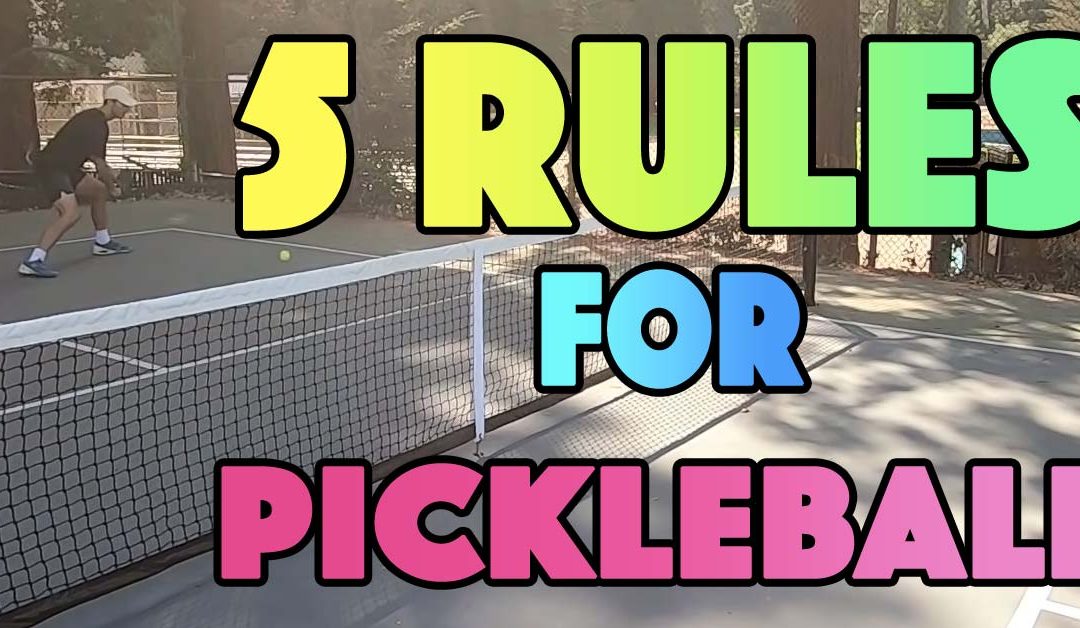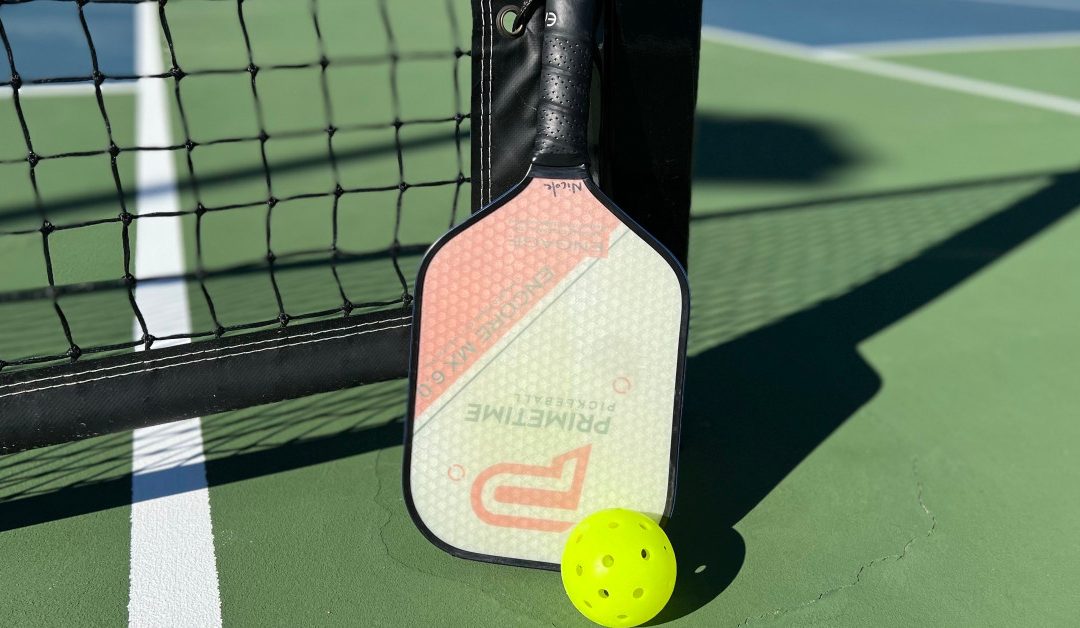We receive so many questions about the different types of 3rd shot drops such as no spin (a.k.a flat) drops, underspin (a.k.a slice or backspin) drops and topspin drops.
If you’re not aware of any of these, don’t worry. We’ll get down to the nitty gritty details on all of these different types of drops in this article.
3rd Shot Drop: A soft shot hit immediately after an opponent’s return of serve (2nd shot) by the server (or the server’s partner) from at or near the baseline. The drop will land in or near the kitchen. The intent of the drop is to allow the server (or the serving team) to safely advance to the net behind it because it forces a low contact point from the returner (or returner’s parter).
We’re also asked how the shape, trajectory and height of the drop changes depending on which spin you decide to hit. You asked, we answered.
We’ll cover exactly that and many more key things you need to be aware of, consider and implement in order to be hitting successful drops that allow you to advance to the net without getting attacked by your opponents.
Goal of the 3rd Shot Drop (& Any Drop Thereafter)
Before we dive into all of that, we first want to cover the main goal of the drop along with the biggest myth about the drop. These two things go hand in hand because if you believe the myth, and attempt to implement it, then it actually prevents you from achieving the goal of the drop.
The big myth surrounding the drop is that you want to land it in the kitchen, the shorter the better. Nothing could be further from the truth.
In order to land the ball short in the kitchen, you have to clear the net by quite a bit more than if you weren’t so concerned about a short, well in the kitchen, target on your drop. The extra and unnecessary height on the drop that would help it land short also, unfortunately, is what causes it to sit up after the bounce and become attackable.
The main goal of the drop is to give you (and your team) an opportunity to advance to the net behind it. If your drop is attackable then you prevent that from happening.
So, you actually want to hit the ball in the deeper part of the kitchen, closer to the NVZ line, and your main objective is to force your opponents into a low contact so that they have to hit up.
When they have to hit up, it gives you the opportunity to sneak up to the NVZ line because it will be very hard to attack you from that contact point.
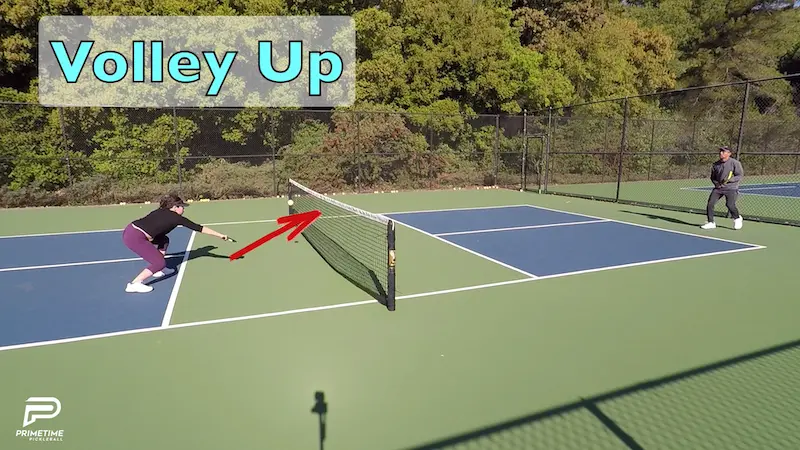
Every time your opponents have to hit up on the ball it’s going to be a lot less aggressive shot than if they are hitting level or down on the ball.
Even if they try to attack the drop from a low contact point with topspin, they still have to clear the net, so they will have to take some pace off their shot and it should be relatively easy for you to handle.
Remember: The goal is to make them hit up and a deeper target is a better option in order to achieve that.
You should aim for your third shots to land around the back quarter of the non-volley zone, towards the non-volley zone line. Even if it lands on the line or slightly behind the line that is ok. Keep that in mind when you’re hitting these third shots.
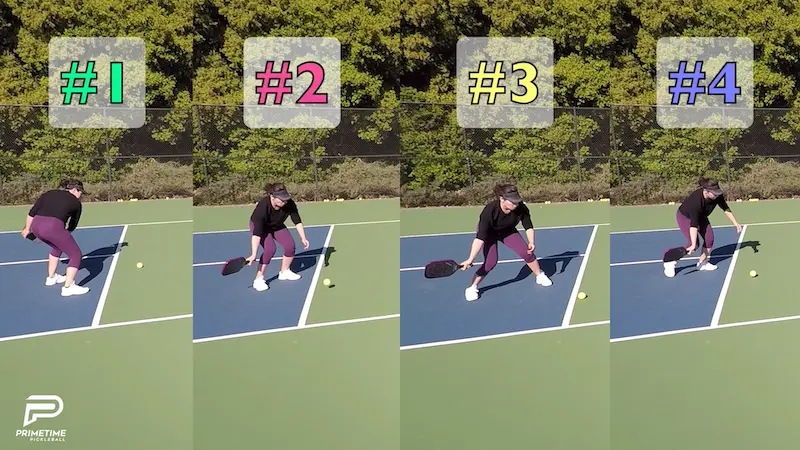
Another thing to keep in mind is that if your opponent is able to volley the ball that does not necessarily mean that your third shot was a bad one. As long as they made contact with it low then you’re good.
How To Hit Aggressive Drops
As we began to cover above, conventional thinking on the drop had us focusing on a target about halfway in the kitchen with a flat drop or what is also thought of as a drop with no spin.
And, as we mentioned, players have now learned that those are attackable if you let them bounce.
You can still use a mostly flat drop as long as your target is deeper in the kitchen, those are still very effective, but there is something you can add to your drops that will make them even more effective.
Spin!
What we’re now seeing more and more is the use of spin drops. Two types of spin are used primarily:
- Slice Drops
- Topspin Drops
Benefits of A Slice Drop
A slice drop is also sometimes referred to as an underspin drop or a backspin drop. All three of these terms can be used interchangeably as they are synonymous.
Slice on a ball is achieved when you cut the ball a little bit from high to low as you hit through it.
Your swing motion will still be very much forward and through with a slight downward angle on your swing and a slightly open face at contact.
The combination of the slight downward swing plus this slight open paddle face is what allows you to still send the ball over the net but also have back spin on the shot.
The trajectory of a well hit slice drop will be flatter as compared to a no spin drop or a topspin drop. This will be necessary because a shot that hits the ground with backspin slows down more than the other two types of shots. If you hit it too high and too slow then it will sit up after the bounce and be attackable.
For this reason, you should hit this type of drops with a flatter arc so that it will stay low to the ground and skid rather that sit up.
Although a slice drop can be hit on the forehand and the backhand side, and we do recommend it on both sides under the right circumstances, it’s a far more natural shot on the backhand (one-handed) side.
Whenever you can, hit your backhand drop with at least some slice on it to help keep the ball lower and make a more difficult shot for your opponents.
It is very difficult to hit a topspin drop on your one-handed backhand. You won’t see anyone do it regularly, including the pros, because it’s so technically difficult.
You absolutely can hit a topspin drop on your backhand side with a two-handed backhand and if you do have that shot (watch any match featuring Riley Newman, he does it routinely) it would be wise to use that as frequently as you can and we’ll dive into why that’s such a good idea in the very next section.
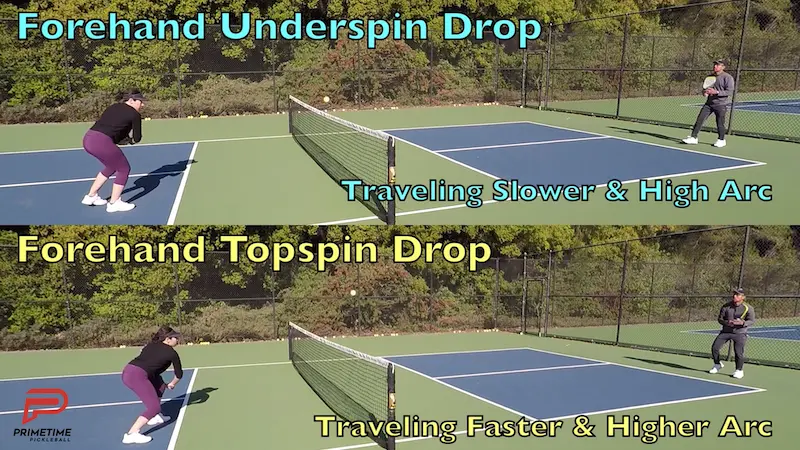
Benefits of a Topspin Drop
The topspin drop is a very powerful tool in the game of pickleball and you’ll want to use it as often as you possibly can.
It has the unique benefit of being quite offensive and putting a lot of pressure on your opponents while also providing a lot of margin of safety to prevent you from hitting it into the net.
One could argue, to an extent, that it’s both offensive and defensive at the same time.
Hitting a third shot with topspin is very effective because you can send it quite high but thanks to the topspin you’ve added on the shot, it then descends fairly quickly, certainly a lot quicker than a slice or flat third shot drop does.
In addition to that, once it hits the ground, it will kick toward your opponent due to the topspin making it nearly impossible to attack.
And furthermore, it’s going to be the most challenging out of all the types of spins for your opponents to judge well because the rate at which the ball drops is hard to read and could be easily misjudged.
The forehand lends itself very well to hitting topspin because biomechanically, once learned, it’s relatively easy to drop your paddle head to get under the ball on your forehand and then come almost straight up vertically with your swing which is what puts topspin on the ball.
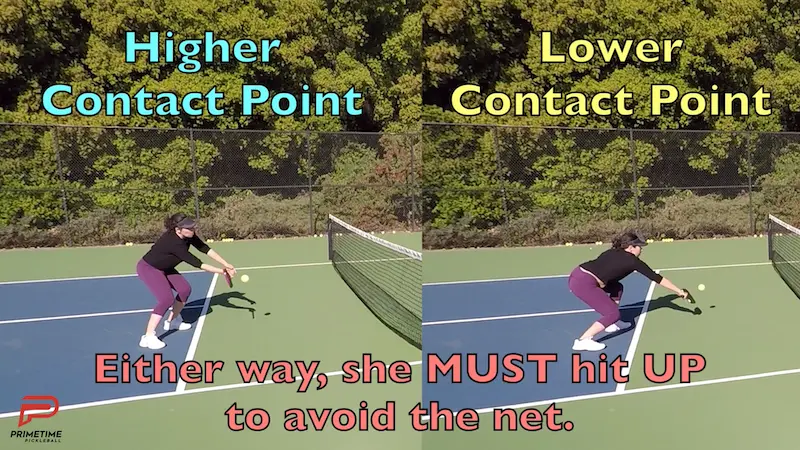
Final Thoughts
Based on what we’ve covered here, it should be quite clear by now that topspin is highly recommended and the clear favorite for what spin to use when hitting a drop because it has the most benefits.
As much as reasonably possible you should seek to hit forehand topspin drops. If you have a one-handed backhand, as many do, then a slice drop is best on that side because one handed drops are just too tough. So tough that even the pros don’t hit them. Should you choose to develop a two-handed backhand drop then that would be the preferred option on that side.
Even though topspin drops are a tremendous tool to have in your arsenal you will often have to resort to slice on both sides because you do need to have the most space under your contact point in order to have enough space to drop your paddle head enough to make the topspin drop a possibility.
That height is not always available if your opponents are able to keep the ball low well.
So, in an ideal world, it would be great to hit topspin drops on everything but since it not always possible the slice is a great option and is more versatile because it can be hit on a lower or a higher contact.

